Skip to content
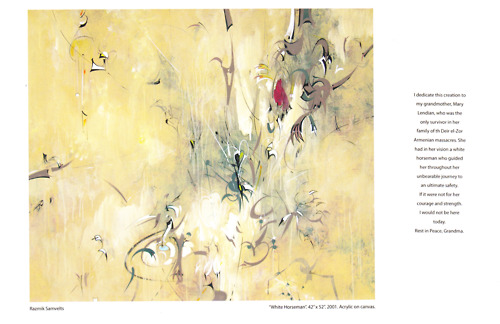 The artist as storyteller – ask painter Razmik Samvelts about any painting he has on display, and be prepared for guidance into the rich particulars of his whereabouts and the experiences that informed the piece. He is an abstract painter, but his working process is closely subjective, and the artist’s personality brings his work to life. Understanding the story of this artist significantly enhances the experience of his art, and the circumstances of being a contemporary artist whose work is inseperable from the community.
The artist as storyteller – ask painter Razmik Samvelts about any painting he has on display, and be prepared for guidance into the rich particulars of his whereabouts and the experiences that informed the piece. He is an abstract painter, but his working process is closely subjective, and the artist’s personality brings his work to life. Understanding the story of this artist significantly enhances the experience of his art, and the circumstances of being a contemporary artist whose work is inseperable from the community.
Samvelts is a living national treasure of Armenia, living in Los Angeles. His personal artistic vision is closely interlaced with tremendous cultural events that have directly impacted the course of his career, making him as much a contemporary artist ahead of his time as he is at the mercy of history’s progress. Discussing the source of his work and his understanding of art, he reflects on his journey with a certain rhythm of point and counterpoint. One message is a spiritual vision addressed to any individual, where life is about seeking the fulfillment of a predetermined purpose. Another message is strength that comes from having close roots as his art played a significant role in his culture’s assertion of independent identity in the Soviet Union during the cold war, a continuation of a long history of the need to assert independence within the confines of empires and occupiers.
The artist’s career was deeply intertwined in Armenian culture from the beginning. Less in the sense of an individual reporting an experience, he is a custodian of the arts arm of a national identity. Children of the Los Angeles Armenian families who show an inclination for visual arts are entrusted to him to receive instruction in the arts, delivered in their own language and infused with their culture. The studio and instruction center he founded in Glendale in 1999 is a true community hall, an enrichment program provided by the community to maintain its own integrity.
He feels that his work is the result of falling exactly in line with a purpose that was pre-determined for him. He is very plain about this: “Do what your heart says, it always tells you something better to do. If you’re true to yourself you will arrive somewhere worthwhile. This is the message that needs to be taught about life. Life is a small light in a vast darkness, lit for a short time. Discover what your purpose is, and do your job wholeheartedly – that’s all.”
In his case, he sees a parallel between fulfilling his heart’s instruction to be a painter, and the role that has come of it for preserving his own culture and becoming an instructor in his own community’s roots. “One should speak their own language,” he will explain, “Roots start in the place where people who are related are speaking with each other. If you’re not good for your family, how can you be good for the community?”
Born in Yerevan, then the Republic of Armenia, he recalls at an early age copying the drawings from ancient history books by David Sassounsi, and wanting from the beginning to engage in art. Gaining an education in the arts within a Soviet led republic wasn’t exactly simple, and required a particular tenacity. Attending school was free, but the young artist did not want to fulfill the requirement that students teach for two years before proceeding to university, wishing to satisfy his desire to continue the study of painting. He had completed a full three years at university before his omission was discovered, and he was unexpectedly removed from the school losing credit for that time. Before being able to return to school he was required to work hard labor, laying railroad line for Nikolai Brezhnev in the swamps and cold of Chita, a region near China.

Returning to university, and resistant to all guidance regarding approved subject matter, he painted “Song” in 1983 as his final project. The subject was Komitas, a composer who went mad during the genocide conducted by Ottoman Empire, as well as haunting figures of various people in traditional costumes who disappeared during that time. The subject and method of the painting was not well received by commissars and school authorities, and acceptance of the painting, which was to tour the country with other final projects, was stalled for 11 months. Eventually it was accepted and displayed, but at the end of the tour it was not returned to the graduate. After some investigation he discovered the painting had been quietly tossed out of doors on the roof of one of the university buildings to be destroyed by the elements. With the help of another former student, he broke into the building, recovered the painting laying exposed in the snow, and repaired it.
The painting has become an important symbolic image for the global Armenian diaspora, the two-thirds of that population which settled outside the country following the genocide. It is reproduced constantly in periodicals, community documents, and anchored his fame and role in his country for perpetuity. It is his best source of income, selling the painting in printed editions.
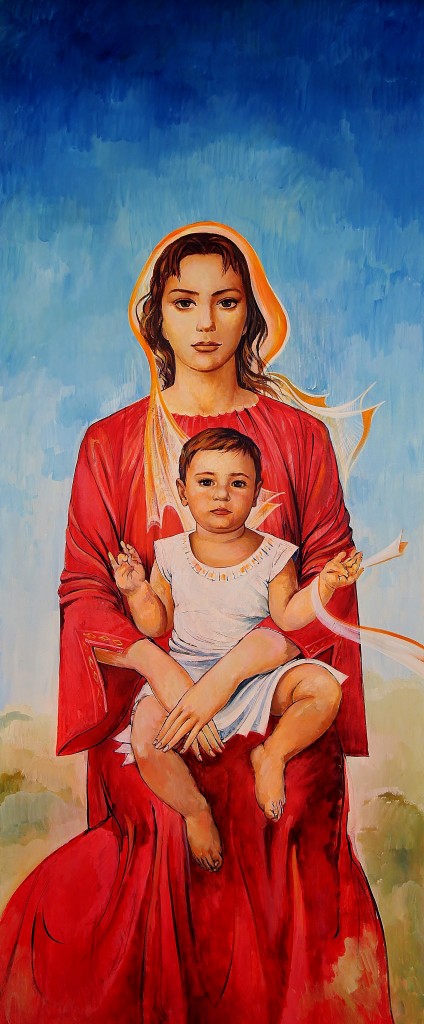
In 1999, during the revolution, an art critic visited his studio in Yerevan and expanded his fortune. Samvelts had no heat, no light and no electricity. His studio was so packed with painted canvases they were of necessity stacked against the windows forcing him to literally work by candle light. Following a sell-out exhibit in Beirut, Lebanon, he gained notice in the west, which led to an invitation to visit and work in a bright apartment in Laguna Beach, and his first experience in the United States where he would eventually make his home.
Samvelts draws his subjects from personal and cultural history, and behind the distinction that can be determined visually there is a story for every painting. He was an eye-witness to the aftermath of a devastating tremor, producing “Earthquake 88.” Drawing from his passion for classical music, a harmonious field surfaced in “Blue Symphony” which is currently on loan to LACMA. Several paintings are dedicated to the subject of the Last Supper, while others relate to the attempt to capture form and shape from the experience of emotions. His work is entirely integrated, the work of an individual painter, family member, and community educator. In a sense, he is a living challenge to see beyond the artist as a professional activity, and instead evaluate one’s personal ability and direction as inseparable from one’s role in a community – life, work and purpose as one.
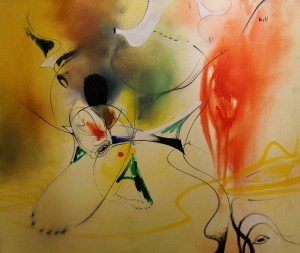
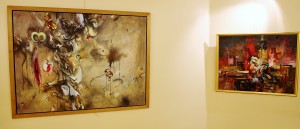
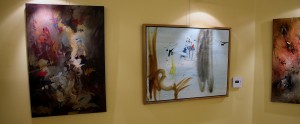
 The artist as storyteller – ask painter Razmik Samvelts about any painting he has on display, and be prepared for guidance into the rich particulars of his whereabouts and the experiences that informed the piece. He is an abstract painter, but his working process is closely subjective, and the artist’s personality brings his work to life. Understanding the story of this artist significantly enhances the experience of his art, and the circumstances of being a contemporary artist whose work is inseperable from the community.
The artist as storyteller – ask painter Razmik Samvelts about any painting he has on display, and be prepared for guidance into the rich particulars of his whereabouts and the experiences that informed the piece. He is an abstract painter, but his working process is closely subjective, and the artist’s personality brings his work to life. Understanding the story of this artist significantly enhances the experience of his art, and the circumstances of being a contemporary artist whose work is inseperable from the community.



